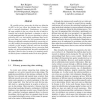Free Online Productivity Tools
i2Speak
i2Symbol
i2OCR
iTex2Img
iWeb2Print
iWeb2Shot
i2Type
iPdf2Split
iPdf2Merge
i2Bopomofo
i2Arabic
i2Style
i2Image
i2PDF
iLatex2Rtf
Sci2ools
83
Voted
CORR
2008
Springer
2008
Springer
Privacy Preserving ID3 over Horizontally, Vertically and Grid Partitioned Data
We consider privacy preserving decision tree induction via ID3 in the case where the training data is horizontally or vertically distributed. Furthermore, we consider the same problem in the case where the data is both horizontally and vertically distributed, a situation we refer to as grid partitioned data. We give an algorithm for privacy preserving ID3 over horizontally partitioned data involving more than two parties. For grid partitioned data, we discuss two different evaluation methods for preserving privacy ID3, namely, first merging horizontally and developing vertically or first merging vertically and next developing horizontally. Next to introducing privacy preserving data mining over grid-partitioned data, the main contribution of this paper is that we show, by means of a complexity analysis that the former evaluation method is the more efficient.
CORR 2008 | Decision Tree | Education | Privacy | Training Data |
Related Content
| Added | 09 Dec 2010 |
| Updated | 09 Dec 2010 |
| Type | Journal |
| Year | 2008 |
| Where | CORR |
| Authors | Bart Kuijpers, Vanessa Lemmens, Bart Moelans, Karl Tuyls |
Comments (0)

